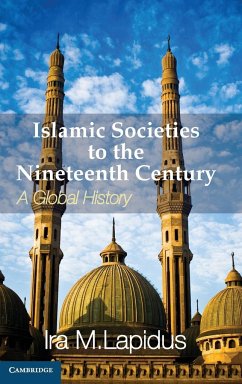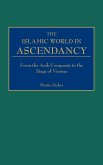Ira M. Lapidus
Islamic Societies to the Nineteenth Century
Ira M. Lapidus
Islamic Societies to the Nineteenth Century
- Gebundenes Buch
- Merkliste
- Auf die Merkliste
- Bewerten Bewerten
- Teilen
- Produkt teilen
- Produkterinnerung
- Produkterinnerung
Based on parts one and two of Ira Lapidus's history, this book traces the transformation of pre-modern Islamic societies and their transfusion globally.
Andere Kunden interessierten sich auch für
![Anglo-Saxon Perceptions of the Islamic World Anglo-Saxon Perceptions of the Islamic World]() Katharine Scarfe BeckettAnglo-Saxon Perceptions of the Islamic World78,99 €
Katharine Scarfe BeckettAnglo-Saxon Perceptions of the Islamic World78,99 €![The Islamic World in Ascendancy The Islamic World in Ascendancy]() Martin SickerThe Islamic World in Ascendancy100,99 €
Martin SickerThe Islamic World in Ascendancy100,99 €![Paradise and Hell in Islamic Traditions Paradise and Hell in Islamic Traditions]() Christian LangeParadise and Hell in Islamic Traditions76,99 €
Christian LangeParadise and Hell in Islamic Traditions76,99 €![The Role Of The Scientific Societies In The Seventeenth Century (1913) The Role Of The Scientific Societies In The Seventeenth Century (1913)]() Martha OrnsteinThe Role Of The Scientific Societies In The Seventeenth Century (1913)24,99 €
Martha OrnsteinThe Role Of The Scientific Societies In The Seventeenth Century (1913)24,99 €![Violence in Islamic Thought from the Qur'an to the Mongols Violence in Islamic Thought from the Qur'an to the Mongols]() Violence in Islamic Thought from the Qur'an to the Mongols144,99 €
Violence in Islamic Thought from the Qur'an to the Mongols144,99 €![Sport and the Pursuit of War and Peace from the Nineteenth Century to the Present Sport and the Pursuit of War and Peace from the Nineteenth Century to the Present]() Sport and the Pursuit of War and Peace from the Nineteenth Century to the Present174,99 €
Sport and the Pursuit of War and Peace from the Nineteenth Century to the Present174,99 €![Extremely Violent Societies Extremely Violent Societies]() Christian GerlachExtremely Violent Societies38,99 €
Christian GerlachExtremely Violent Societies38,99 €-
-
-
Based on parts one and two of Ira Lapidus's history, this book traces the transformation of pre-modern Islamic societies and their transfusion globally.
Hinweis: Dieser Artikel kann nur an eine deutsche Lieferadresse ausgeliefert werden.
Hinweis: Dieser Artikel kann nur an eine deutsche Lieferadresse ausgeliefert werden.
Produktdetails
- Produktdetails
- Verlag: Cambridge University Press
- Seitenzahl: 796
- Erscheinungstermin: 13. Dezember 2012
- Englisch
- Abmessung: 235mm x 157mm x 47mm
- Gewicht: 1282g
- ISBN-13: 9780521514415
- ISBN-10: 052151441X
- Artikelnr.: 35113079
- Herstellerkennzeichnung
- Libri GmbH
- Europaallee 1
- 36244 Bad Hersfeld
- gpsr@libri.de
- Verlag: Cambridge University Press
- Seitenzahl: 796
- Erscheinungstermin: 13. Dezember 2012
- Englisch
- Abmessung: 235mm x 157mm x 47mm
- Gewicht: 1282g
- ISBN-13: 9780521514415
- ISBN-10: 052151441X
- Artikelnr.: 35113079
- Herstellerkennzeichnung
- Libri GmbH
- Europaallee 1
- 36244 Bad Hersfeld
- gpsr@libri.de
Ira Lapidus is Professor Emeritus of History at the University of California, Berkeley. Throughout his long and illustrious career he has published extensively. His abiding interest has been the relationship between the family, the tribe and the city, and this is exemplified in his current work and previous publications, including Contemporary Islamic Movements in Historical Perspective (1983), Muslim Cities in the Later Middle Ages (1984), Islam, Politics and Social Movements, co-edited with Edmund Burke (1988) and A History of Islamic Societies (1988, 2002).
Introduction to the history of Islamic societies
Book I. Part I. The Beginnings of Islamic Civilizations, The Middle East from c.600 to c.1000: 1. Middle Eastern societies before Islam
2. Historians and the sources
3. Arabia
4. Muhammad: preaching, community, and state formation
5. Introduction
6. The Arab-Muslim conquests and the socio-economic bases of empire
7. Regional developments: economic and social changes
8. The caliphate to 750
9. The 'Abbasid empire
10. Decline and fall of the 'Abbasid empire
11. Introduction: religion and identity
12. The ideology of imperial Islam
13. The 'Abbasids: caliphs and emperors
14. Introduction
15. Sunni Islam
16. Shi'i Islam
17. Muslim urban societies to the tenth century
18. The non-Muslim minorities
19. Continuity and change in the historic cultures of the Middle East
Book I. Part II. From Islamic Community to Islamic Society: Egypt, Iraq and Iran, 945-c.1500: 20. The post-'Abbasid Middle Eastern state system
21. Muslim communities and Middle Eastern societies: 1000-1500 CE
22. The collective ideal
23. The personal ethic
24. Conclusion: Middle Eastern Islamic patterns
Book II. The Global Expansion of Islam from the Seventh to the Nineteenth Century: 25. Introduction: Islamic institutions
26. Islamic north Africa to the thirteenth century
27. Spanish-Islamic civilization
28. Libya, Tunisia, Algeria, and Morocco from the thirteenth to the nineteenth centuries
29. States and Islam: North African variations
30. Introduction: empires and societies
31. The Turkish migrations and the Ottoman empire
32. The post-classical Ottoman empire: decentralization, commercialization, incorporation
33. The Arab regions of the Middle East
34. The Safavid empire
35. The Indian subcontinent: the Delhi sultanates and the Mughal empire
36. Islamic empires compared
37. Inner Asia from the Mongol conquests to the nineteenth century
38. Islamic societies in Southeast Asia
39. The African context: Islam, slavery, and colonialism
40. Islam in Sudanic, Savannah, and forest west Africa
41. The West African jihads
42. Islam in East Africa and the European colonial empires
43. Conclusion: the varieties of Islamic societies
44. The global context.
Book I. Part I. The Beginnings of Islamic Civilizations, The Middle East from c.600 to c.1000: 1. Middle Eastern societies before Islam
2. Historians and the sources
3. Arabia
4. Muhammad: preaching, community, and state formation
5. Introduction
6. The Arab-Muslim conquests and the socio-economic bases of empire
7. Regional developments: economic and social changes
8. The caliphate to 750
9. The 'Abbasid empire
10. Decline and fall of the 'Abbasid empire
11. Introduction: religion and identity
12. The ideology of imperial Islam
13. The 'Abbasids: caliphs and emperors
14. Introduction
15. Sunni Islam
16. Shi'i Islam
17. Muslim urban societies to the tenth century
18. The non-Muslim minorities
19. Continuity and change in the historic cultures of the Middle East
Book I. Part II. From Islamic Community to Islamic Society: Egypt, Iraq and Iran, 945-c.1500: 20. The post-'Abbasid Middle Eastern state system
21. Muslim communities and Middle Eastern societies: 1000-1500 CE
22. The collective ideal
23. The personal ethic
24. Conclusion: Middle Eastern Islamic patterns
Book II. The Global Expansion of Islam from the Seventh to the Nineteenth Century: 25. Introduction: Islamic institutions
26. Islamic north Africa to the thirteenth century
27. Spanish-Islamic civilization
28. Libya, Tunisia, Algeria, and Morocco from the thirteenth to the nineteenth centuries
29. States and Islam: North African variations
30. Introduction: empires and societies
31. The Turkish migrations and the Ottoman empire
32. The post-classical Ottoman empire: decentralization, commercialization, incorporation
33. The Arab regions of the Middle East
34. The Safavid empire
35. The Indian subcontinent: the Delhi sultanates and the Mughal empire
36. Islamic empires compared
37. Inner Asia from the Mongol conquests to the nineteenth century
38. Islamic societies in Southeast Asia
39. The African context: Islam, slavery, and colonialism
40. Islam in Sudanic, Savannah, and forest west Africa
41. The West African jihads
42. Islam in East Africa and the European colonial empires
43. Conclusion: the varieties of Islamic societies
44. The global context.
Introduction to the history of Islamic societies
Book I. Part I. The Beginnings of Islamic Civilizations, The Middle East from c.600 to c.1000: 1. Middle Eastern societies before Islam
2. Historians and the sources
3. Arabia
4. Muhammad: preaching, community, and state formation
5. Introduction
6. The Arab-Muslim conquests and the socio-economic bases of empire
7. Regional developments: economic and social changes
8. The caliphate to 750
9. The 'Abbasid empire
10. Decline and fall of the 'Abbasid empire
11. Introduction: religion and identity
12. The ideology of imperial Islam
13. The 'Abbasids: caliphs and emperors
14. Introduction
15. Sunni Islam
16. Shi'i Islam
17. Muslim urban societies to the tenth century
18. The non-Muslim minorities
19. Continuity and change in the historic cultures of the Middle East
Book I. Part II. From Islamic Community to Islamic Society: Egypt, Iraq and Iran, 945-c.1500: 20. The post-'Abbasid Middle Eastern state system
21. Muslim communities and Middle Eastern societies: 1000-1500 CE
22. The collective ideal
23. The personal ethic
24. Conclusion: Middle Eastern Islamic patterns
Book II. The Global Expansion of Islam from the Seventh to the Nineteenth Century: 25. Introduction: Islamic institutions
26. Islamic north Africa to the thirteenth century
27. Spanish-Islamic civilization
28. Libya, Tunisia, Algeria, and Morocco from the thirteenth to the nineteenth centuries
29. States and Islam: North African variations
30. Introduction: empires and societies
31. The Turkish migrations and the Ottoman empire
32. The post-classical Ottoman empire: decentralization, commercialization, incorporation
33. The Arab regions of the Middle East
34. The Safavid empire
35. The Indian subcontinent: the Delhi sultanates and the Mughal empire
36. Islamic empires compared
37. Inner Asia from the Mongol conquests to the nineteenth century
38. Islamic societies in Southeast Asia
39. The African context: Islam, slavery, and colonialism
40. Islam in Sudanic, Savannah, and forest west Africa
41. The West African jihads
42. Islam in East Africa and the European colonial empires
43. Conclusion: the varieties of Islamic societies
44. The global context.
Book I. Part I. The Beginnings of Islamic Civilizations, The Middle East from c.600 to c.1000: 1. Middle Eastern societies before Islam
2. Historians and the sources
3. Arabia
4. Muhammad: preaching, community, and state formation
5. Introduction
6. The Arab-Muslim conquests and the socio-economic bases of empire
7. Regional developments: economic and social changes
8. The caliphate to 750
9. The 'Abbasid empire
10. Decline and fall of the 'Abbasid empire
11. Introduction: religion and identity
12. The ideology of imperial Islam
13. The 'Abbasids: caliphs and emperors
14. Introduction
15. Sunni Islam
16. Shi'i Islam
17. Muslim urban societies to the tenth century
18. The non-Muslim minorities
19. Continuity and change in the historic cultures of the Middle East
Book I. Part II. From Islamic Community to Islamic Society: Egypt, Iraq and Iran, 945-c.1500: 20. The post-'Abbasid Middle Eastern state system
21. Muslim communities and Middle Eastern societies: 1000-1500 CE
22. The collective ideal
23. The personal ethic
24. Conclusion: Middle Eastern Islamic patterns
Book II. The Global Expansion of Islam from the Seventh to the Nineteenth Century: 25. Introduction: Islamic institutions
26. Islamic north Africa to the thirteenth century
27. Spanish-Islamic civilization
28. Libya, Tunisia, Algeria, and Morocco from the thirteenth to the nineteenth centuries
29. States and Islam: North African variations
30. Introduction: empires and societies
31. The Turkish migrations and the Ottoman empire
32. The post-classical Ottoman empire: decentralization, commercialization, incorporation
33. The Arab regions of the Middle East
34. The Safavid empire
35. The Indian subcontinent: the Delhi sultanates and the Mughal empire
36. Islamic empires compared
37. Inner Asia from the Mongol conquests to the nineteenth century
38. Islamic societies in Southeast Asia
39. The African context: Islam, slavery, and colonialism
40. Islam in Sudanic, Savannah, and forest west Africa
41. The West African jihads
42. Islam in East Africa and the European colonial empires
43. Conclusion: the varieties of Islamic societies
44. The global context.








